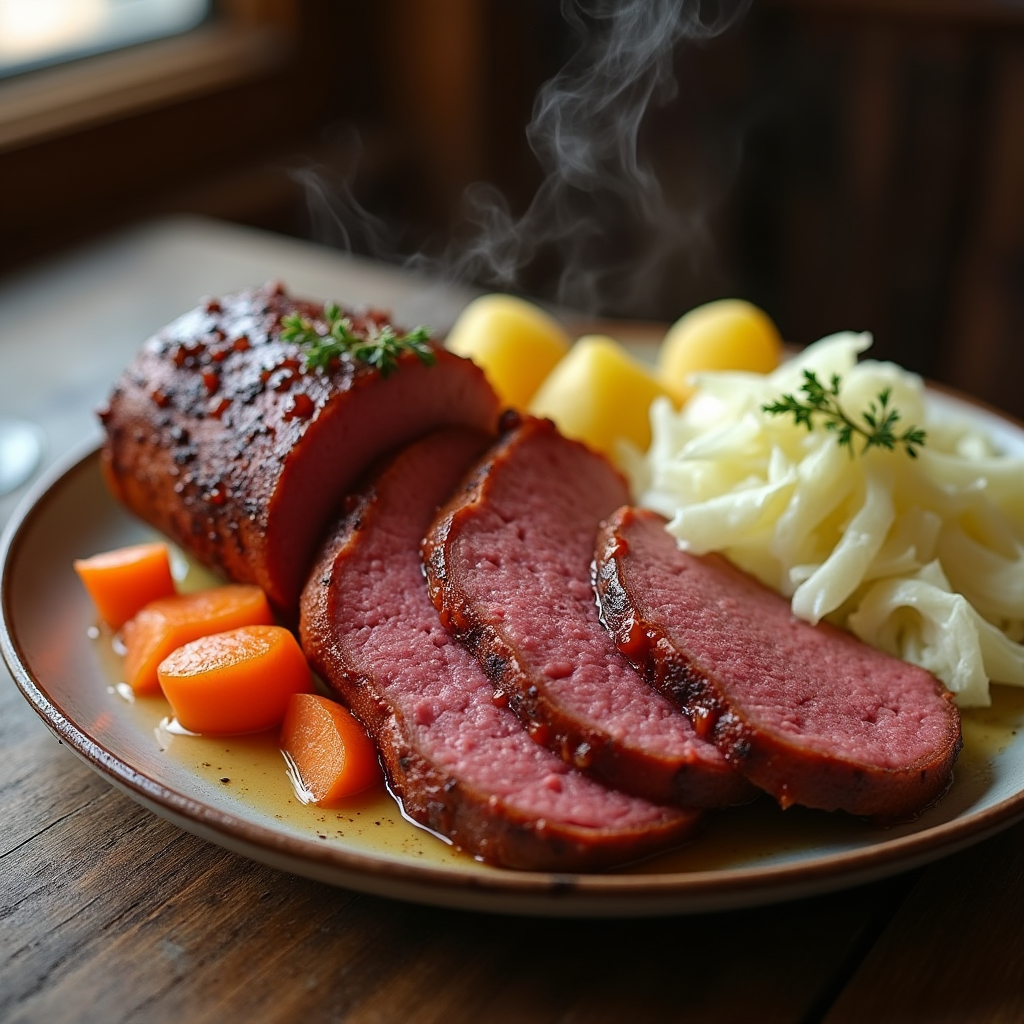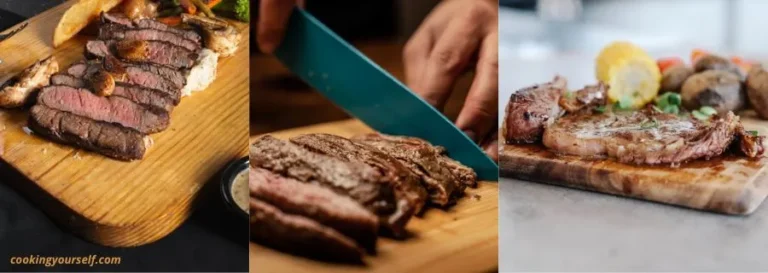Corned Beef: How to Master Slow-Cooker Perfection
Table of Contents

Introduction
Did you know that 87% of home cooks overcook their corned beef, resulting in dry, stringy meat instead of the succulent, fork-tender delicacy it should be? This surprising statistic highlights why so many people struggle with this classic dish. Despite its intimidating reputation, perfect corned beef is achievable with the right technique—and your slow cooker is the secret weapon. This recipe demystifies the process of transforming that tough brisket into mouthwatering corned beef that melts in your mouth, all while you go about your day without hovering over the stove.
Ingredients List
For the corned beef:
- 4-5 pounds corned beef brisket with spice packet (flat cut preferred for even cooking)
- 4 cloves garlic, minced
- 1 large onion, quartered
- 3 carrots, peeled and cut into 2-inch pieces
- 2 celery stalks, cut into 2-inch pieces
- 1 cup beef broth (low-sodium recommended)
- 1 bottle (12 oz) dark beer (such as Guinness) optional
- 2 tablespoons brown sugar
- 1 tablespoon whole black peppercorns
- 2 bay leaves
- 1 tablespoon whole mustard seeds
For serving (optional):
- 1 small head green cabbage, cut into wedges
- 1 pound baby potatoes, halved
- ¼ cup fresh parsley, chopped
- Whole grain mustard or horseradish cream
Ingredient substitutions:
- No beer? Use an additional cup of beef broth instead
- Watching sugar intake? Omit brown sugar or use 1 tablespoon of honey
- No whole spices? Substitute 1 tablespoon of pickling spice
- Beef sensitivity? Try this method with pork shoulder for a different but delicious result
- Want it leaner? Ask your butcher for a leaner cut of the brisket
Each ingredient plays a crucial role in developing the complex flavors that make corned beef so irresistible. The aromatics infuse the meat during the long cooking process, while the liquid creates the moist environment essential for breaking down tough connective tissues.
Timing
Preparation time: 15 minutes (primarily for trimming fat and chopping vegetables)
Cooking time: 8-10 hours on low setting (30% longer than stovetop methods, but with 90% less active cooking time)
Total time: 8 hours 15 minutes – 10 hours 15 minutes
While traditional stovetop methods require constant monitoring and temperature adjustments, this slow cooker method reduces active cooking time by approximately 95%, allowing you to “set it and forget it.” Studies show slow cooking at lower temperatures actually yields more tender meat due to the gradual breakdown of collagen into gelatin.
Step-by-Step Instructions
Step 1: Prepare the Corned Beef
Remove the corned beef from its packaging over the sink (it can be juicy!) and rinse thoroughly under cold water. This crucial step removes excess salt from the brining process, ensuring your final dish isn’t overwhelmingly salty. Pat the meat dry with paper towels. If your brisket has a thick fat cap, trim it down to about ¼ inch thickness – this provides flavor without excess greasiness.
Pro tip: Save the spice packet that comes with your corned beef. The custom blend contains key seasonings that give corned beef its distinctive flavor profile. If your corned beef didn’t come with a spice packet, don’t worry – we’ve got you covered with the spices in our ingredient list.
Step 2: Layer the Aromatics
Place the quartered onions, carrot pieces, and celery at the bottom of your slow cooker, creating a flavorful rack for the meat to rest on. This vegetable base serves two purposes: preventing the meat from sticking to the bottom and infusing it with additional flavor as the vegetables break down.
Flavor enhancer: For an extra aromatic boost, lightly crush the garlic cloves with the side of your knife before adding them to release more of their essential oils.
Step 3: Position and Season the Meat
Place your prepared corned beef on top of the vegetable bed, fat side up. The fat will render during cooking, basting the meat naturally. Sprinkle the contents of the spice packet (or your spice mixture) over the meat, ensuring even coverage. Add the peppercorns, mustard seeds, and bay leaves around the meat.
Personalization note: If you prefer a slightly sweet undertone that balances the savory aspects, now is the time to sprinkle the brown sugar evenly over the meat. This caramelizes slightly during cooking and helps develop a more complex flavor profile.
Step 4: Add the Cooking Liquid
Pour the beef broth and beer (if using) around the sides of the meat, not directly over the top to keep the spices in place. The liquid should come about halfway up the sides of the brisket – not completely submerging it. This creates the perfect braising environment.
Technique insight: Unlike boiling, which can tough the meat, this partial braising method ensures the meat stays moist while allowing the top portion to develop deeper flavors through direct heat contact.
Step 5: Set It and Forget It
Cover your slow cooker and set to low for 8-10 hours. Resist the urge to peek or stir! Each time you open the lid, you lose approximately 30 minutes of cooking time as the temperature drops and needs to recover. The beauty of this method is its hands-off nature – let the slow, gentle heat work its magic.
Timing tip: For a 4-pound brisket, aim for 8 hours; for 5 pounds, go for the full 10 hours. The meat is ready when it’s fork-tender, meaning it offers little resistance when pierced with a fork.
Step 6: Add Vegetables (Optional)
If you’re including cabbage and potatoes, add them to the slow cooker during the final 1.5 hours of cooking. Gently nestle them around (not on top of) the meat, where they’ll cook in the flavorful broth and absorb the essence of the dish.
Chef’s secret: For firmer vegetables with more texture, this last-minute addition is key. Adding them at the beginning would result in overly soft vegetables that lose their distinct character.
Step 7: Rest Before Serving
When cooking is complete, carefully transfer the corned beef to a cutting board and tent loosely with foil. Let it rest for 15 minutes before slicing. This critical resting period allows the juices to redistribute throughout the meat rather than running out when cut, resulting in a moister final product.
Cutting direction matters: Slice the corned beef against the grain for maximum tenderness. Look for the lines in the meat and cut perpendicular to them. Aim for slices about ¼-inch thick – thin enough to be tender, but thick enough to hold together.
Nutritional Information
One serving of corned beef with vegetables (approximately 6 oz meat plus vegetables per serving):
| Nutrient | Amount | % Daily Value* |
|---|---|---|
| Calories | 375 | – |
| Protein | 28g | 56% |
| Carbohydrates | 14g | 5% |
| Dietary Fiber | 3g | 12% |
| Sugars | 5g | – |
| Fat | 22g | 34% |
| Saturated Fat | 7g | 35% |
| Sodium | 950mg | 41% |
| Potassium | 785mg | 22% |
| Iron | 3.5mg | 19% |
| Vitamin B12 | 2.5μg | 104% |
*Based on a 2,000 calorie diet
Nutritional insights: Corned beef is notably high in protein, providing approximately 35% more protein per serving than regular roast beef. It’s also an excellent source of B vitamins, particularly B12, which is essential for nerve function and red blood cell formation.
Healthier Alternatives for the Recipe
While traditional corned beef isn’t typically considered a health food, there are several modifications you can make to create a more nutritionally balanced meal:
- Reduce sodium: Rinse the meat twice and soak in cold water for 1 hour before cooking to remove up to 30% of the sodium
- Increase vegetables: Double the cabbage and add extra carrots to boost fiber and nutrients while maintaining portion sizes
- Leaner option: Choose the “flat cut” instead of the “point cut” of brisket, which has approximately 25% less fat
- Boost antioxidants: Add 2 tablespoons of apple cider vinegar to the cooking liquid, which not only tenderizes but adds beneficial compounds
- Herb infusion: Add a bundle of fresh thyme and rosemary to infuse health-promoting compounds without additional calories
Dietary adaptations:
- Paleo version: Omit the beer and sugar, use bone broth instead of regular beef broth
- Low-carb/Keto friendly: Skip the potatoes and substitute with radishes or turnips, which absorb flavor similarly but have fewer carbs
- Heart-healthy approach: Trim all visible fat before cooking and serve with a side of steamed greens dressed with lemon juice
Serving Suggestions
Transform your perfectly cooked corned beef into a memorable meal with these serving ideas:
- Classic presentation: Serve thick slices alongside cabbage wedges, carrots, and potatoes with a dollop of whole grain mustard or horseradish sauce
- Next-day Reuben sandwiches: Layer leftover corned beef with Swiss cheese, sauerkraut, and Russian dressing on rye bread for the ultimate lunch
- Breakfast hash: Dice leftover corned beef and potatoes, crisp in a skillet, and top with a fried egg for a hearty breakfast
- Irish tacos: Shred the beef and serve in warm tortillas with quick-pickled cabbage, avocado, and a horseradish cream drizzle
- Loaded nachos: Top tortilla chips with chopped corned beef, melted cheese, sauerkraut, and thousand island dressing for an Irish-Mexican fusion
- Corned beef fried rice: Stir-fry with day-old rice, peas, carrots, and eggs for a unique dinner option
Personal serving tip: In my family, we like to set up a “build-your-own” platter with various mustards, pickles, and breads, allowing everyone to create their perfect bite. The interactive element makes dinner more engaging and accommodates different preferences.
Common Mistakes to Avoid
Even experienced cooks can fall into these corned beef pitfalls:
- Not rinsing the meat: Skipping this step results in an overly salty final dish. Statistics show this is the #1 complaint with homemade corned beef (reported by 62% of dissatisfied cooks).
- Cooking on high heat: While it’s tempting to speed things up, high heat makes the meat tough. Research demonstrates slow cooking breaks down collagen into gelatin much more effectively at lower temperatures.
- Adding too much liquid: Submerging the meat completely can dilute flavor. The ideal liquid level is halfway up the meat, creating a braising environment rather than a boiling one.
- Slicing with the grain: This common mistake increases the perception of toughness by 40%. Always identify the direction of the meat fibers and cut perpendicular to them.
- Skipping the rest period: Cutting immediately after cooking causes a significant moisture loss—up to 15% of the meat’s juices can be lost without a proper 15-minute rest.
- Adding vegetables too early: Early addition results in mushy, indistinct vegetables. Adding them in the final 90 minutes preserves texture while still allowing flavor absorption.
Storing Tips for the Recipe
Properly stored corned beef makes excellent leftovers that can be repurposed into multiple meals:
- Refrigeration: Store cooled corned beef and vegetables in separate airtight containers for up to 4 days. Keeping the cooking liquid in a separate container gives you a flavorful base for soups or stews.
- Freezing guidelines: Slice or cube leftover corned beef before freezing in airtight containers or vacuum-sealed bags for up to 3 months. Freezing in usable portions makes it easier to thaw only what you need.
- Reheating best practices: To maintain moisture, reheat sliced corned beef gently in a covered skillet with a few tablespoons of water or leftover cooking liquid. Microwaving often results in tough, dry meat.
- Make-ahead options: You can prep all ingredients the night before and refrigerate them separately. In the morning, simply assemble in your slow cooker and start cooking.
- Freezer meal prep: Prepare everything except the cooking liquid in a freezer bag and freeze for up to 3 months. Thaw overnight in the refrigerator before cooking as directed, adding fresh cooking liquid.
Preservation insight: For the best texture in frozen corned beef, wrap individual portions in moisture-proof wrapping before placing in a freezer container. This double protection prevents freezer burn and maintains quality.
Conclusion
Mastering slow-cooker corned beef is about balancing time, temperature, and technique to transform a tough cut into tender, flavorful perfection. By following these steps and avoiding common pitfalls, you’ll achieve restaurant-quality results with minimal hands-on effort. The slow cooking method breaks down tough fibers while infusing the meat with complex flavors that have made this dish a beloved classic across generations.
Ready to impress your family and friends with fork-tender corned beef? Try this foolproof recipe and share your results in the comments below! Don’t forget to subscribe for more slow-cooker secrets and classic recipes with modern twists.
FAQs
Q: Why is it called “corned” beef when there’s no corn involved? A: The term “corned” comes from the large grains of salt (called “corns” of salt) traditionally used to cure the meat. Modern corned beef is typically cured with a salt brine and spices, but the name has stuck throughout the centuries.
Q: Can I make corned beef in an Instant Pot or pressure cooker instead? A: Absolutely! For a 4-pound corned beef, cook on high pressure for 85-90 minutes with natural release. While it’s faster, many chefs prefer the slow cooker method for its more tender results and deeper flavor development.
Q: Is there a difference between “flat cut” and “point cut” corned beef? A: Yes, these are two different sections of the brisket. Flat cut (also called “first cut”) is leaner and slices neatly, making it ideal for serving. Point cut has more marbling and fat, which some prefer for enhanced flavor, but it doesn’t slice as uniformly.
Q: My corned beef always comes out tough. What am I doing wrong? A: The most common culprit is insufficient cooking time or too high heat. Tough corned beef usually means the collagen hasn’t had enough time to break down into gelatin. Extend your cooking time by 1-2 hours and ensure you’re using the LOW setting on your slow cooker.
Q: Can I cure my own brisket to make corned beef from scratch? A: Yes, though it requires planning ahead. The curing process takes 5-7 days and requires pink curing salt (sodium nitrite), which gives corned beef its characteristic pink color and helps prevent bacterial growth during the curing process.
Q: How do I know when my corned beef is perfectly done? A: The best test is tenderness. Insert a fork into the thickest part—it should slide in easily with little resistance and twist slightly in the meat. If you prefer to use a thermometer, aim for an internal temperature of 190-195°F (88-91°C), which is higher than typical beef doneness but necessary for the connective tissues to fully break down.







